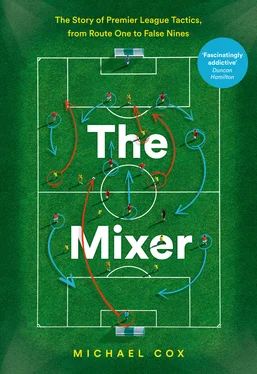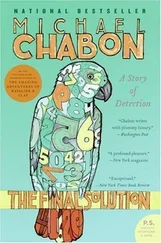The purchase of a player in Cantona’s mould revolutionised United’s tactical approach overnight. While Ferguson unquestionably deserves enormous credit for United’s success during this period, his side lacked a defined style until the Frenchman’s arrival. Ferguson encouraged attack-minded football with width, in keeping with United’s traditions – but there was a rudimentary approach in the final third, epitomised by the time winger Andrei Kanchelskis stormed off the training pitch in frustration at yet another crossing drill, muttering ‘English football is shit’ on his way – not an unreasonable comment at the time. Ferguson was considered a man-manager rather than a footballing philosopher or astute tactician. Schmeichel, who would become Cantona’s roommate on away trips, summarised Cantona’s first training session concisely. ‘From that day, Manchester United’s style of play changed,’ he said. ‘The arrival of Cantona suddenly made it clear to the coaching staff exactly how the team should play to be successful.’ Cantona was the catalyst for United’s revolution, and their success set the tone for the tactical development of rival Premier League clubs, which was initially accelerated by the influence of inspirational foreign players rather than managerial philosophies.
Cantona was capable of playing either as a traditional centre-forward or as a playmaker, having filled both roles at various stages of his career. For United, he was generally used in the number 10 role behind a traditional striker, effectively turning United’s 4–4–2 system into a 4–4–1–1. The Premier League had very few deep-lying forwards in this mould; Teddy Sheringham, who would later replace Cantona at United, became renowned as an excellent ‘withdrawn’ forward, although at this stage was more of a target man, winning the inaugural Premier League Golden Boot with 22 goals, having transferred from Nottingham Forest to Tottenham three games into the campaign. Southampton’s Matt Le Tissier was in a similar mould to Cantona, but was suffering under the management of Ian Branfoot, who wanted his defenders to thump long balls downfield. Neither Sheringham nor Le Tissier had yet been capped by England. Peter Beardsley, another of Ferguson’s targets, was the most similar type of forward, although often found himself out of the Everton side. Besides, Beardsley lacked Cantona’s flamboyance and wasn’t superstar material – he was among the quietest, humblest players in the top flight, whereas Cantona was surely the most arrogant, albeit with some justification.
English football was historically suspicious of deep-lying forwards, despite the likes of Ferenc Puskás and Diego Maradona causing the national team so much misery over the years. It was considered a foreign role, and extravagance in English football was usually the domain of tricky wingers, with Tom Finney, Stanley Matthews and George Best among the most revered players. Even Paul Gascoigne, England’s most talented player of this era, was a number 8 rather than a number 10, a midfielder who burst forward from deep. It was unfortunate the Premier League didn’t witness Gascoigne at his best: he spent its first six years with Lazio and then Rangers, only returning to England with Middlesbrough and Everton in his thirties. Ferguson, incidentally, says being beaten by Spurs to Gascoigne’s signature in 1988 is one of his biggest regrets in football, and Gascoigne would later phone Ferguson in the summer of 1995 (when Cantona was serving his eight-month ban and intending to leave England) begging for a move to United. Ferguson, however, concentrated on convincing Cantona to stay.
Ferguson had a close relationship with Cantona throughout his five years at Old Trafford. Whereas Ferguson took a schoolmasterly approach to the majority of his players, Cantona was afforded the rare privilege of a cup of tea with his manager before training every day, and while it’s difficult to imagine anyone entirely understood Cantona, Ferguson came closest. Managers often suggest the toughest part of their job is affording star players special treatment without prompting dissent from the rest of the squad, and Ferguson quickly realised he needed to make allowances for Cantona, sparing him from blasts of ‘the hairdryer’, as Manchester United players called Ferguson’s tendency to scream in their faces after bad performances.
Winger Lee Sharpe tells an amusing, revealing anecdote about the United squad’s reception at Manchester Town Hall shortly after their first title victory. The rest of the squad wore smart black suits, but Sharpe arrived in an olive-green silk outfit with a green tie. This inevitably prompted Ferguson to come over and admonish him, at which point Cantona strolled into the room with a suit, no tie – and red Nike trainers. Ferguson let out a cry of frustration and simply stormed off. A similar incident occurred when Ferguson was about to criticise Sharpe for getting a skinhead haircut on a pre-season tour, only to suddenly notice Cantona had the same, forcing him to bite his tongue. ‘There were times when the different treatment Eric got was laughable,’ Sharpe complained. ‘It was one set of rules for him, and another for the likes of me.’ After Cantona’s infamous kung-fu kick at Selhurst Park, Ferguson’s first instinct in the dressing room afterwards was to complain about sloppy defending for Crystal Palace’s equaliser.
In general, footballers accept a star teammate being indulged, and on the pitch Cantona was effectively handed a free role with licence to roam wherever he pleased. He contributed little in defensive situations, as Roy Keane later recalled. ‘Often we’d give him a bollocking for not tracking back. We certainly did more than our share of running for him. Then, just when exasperation was being felt, and expressed, Eric would produce a bit of magic to turn the game our way.’ English football was learning that players in Cantona’s mould were worth embracing, worth freeing from defensive responsibilities, and a footballing culture that valued hard work and commitment above everything else was forced to reconsider its principles. United’s youth coach Eric Harrison, upon first seeing Cantona in training, said he ‘wanted to kidnap him and spend a week talking to him about football’.
Tactically, opponents simply weren’t structured for stopping Cantona. Ordinarily, centre-backs were fighting against centre-forwards, and central midfielders were involved in running battles with their opposite numbers. Players like Cantona, who interpreted the game differently and dropped into the space between opposition defenders and midfielders, were able to enjoy plenty of time on the ball. ‘Eric, no matter the tempo or the maelstrom of Premier League football,’ Ferguson said, ‘has that ability to put his foot on the ball and to make his passes. That in itself is almost a miracle.’ So much of this, however, was simply about Cantona’s initial positioning, combined with his ability to hold off defenders when they approached. Previously, United had focused on attacking down the flanks, or hitting longer passes to centre-forward Hughes, who was superb at bringing down high balls and feeding teammates. But Cantona orchestrated United’s attacking play wonderfully, and like the very best number 10s – particularly Maradona, but also, in Premier League terms, Dennis Bergkamp and Gianfranco Zola – was a selfless footballer who recognised that his individual freedom should be used for the collective good.
In addition to Cantona’s on-field contribution, he was also a tremendous example to his teammates in training. He insisted upon some level of autonomy – his own warm-up routines before joining in with the other players’ warm-up, for example – but United teammates agree he raised the standard of training considerably. His professionalism inspired the club’s emerging youngsters, including the ‘class of ’92’, featuring Giggs, David Beckham, Nicky Butt, Paul Scholes, and Gary and Phil Neville, surely the greatest set of footballers ever produced by an English youth academy.
Читать дальше












